Satellite RNA-derived small interfering RNA satsiR-12 targeting the 3' untranslated region of Cucumber mosaic virus triggers viral RNAs for degradation
- PMID: 21994448
- PMCID: PMC3233178
- DOI: 10.1128/JVI.05806-11
Satellite RNA-derived small interfering RNA satsiR-12 targeting the 3' untranslated region of Cucumber mosaic virus triggers viral RNAs for degradation
Abstract
RNA silencing provides protection against RNA viruses by targeting both the helper virus and its satellite RNA (satRNA). Virus-derived small interfering RNAs (vsiRNAs) bound with Argonaute (AGO) proteins are presumed participants in the silencing process. Here, we show that a vsiRNA targeted to virus RNAs triggers the host RNA-dependent RNA polymerase 6 (RDR6)-mediated degradation of viral RNAs. We confirmed that satRNA-derived small interfering RNAs (satsiRNAs) could be associated with different AGO proteins in planta. The most frequently cloned satsiRNA, satsiR-12, was predicted to imperfectly match to Cucumber mosaic virus (CMV) RNAs in the upstream area of the 3' untranslated region (3' UTR). Moreover, an artificial satsiR-12 (asatsiR-12) mediated cleavage of a green fluorescent protein (GFP) sensor construct harboring the satsiR-12 target site. asatsiR-12 also mediated reduction of viral RNAs in 2b-deficient CMV (CMVΔ2b)-infected Nicotiana benthamiana. The reduction was not observed in CMVΔ2b-infected RDR6i plants, in which RDR6 was silenced. Following infection with 2b-containing CMV, the reduction in viral RNAs was not observed in plants of either genotype, indicating that the asatsiR-12-mediated reduction of viral RNAs in the presence of RDR6 was inhibited by the 2b protein. Our results suggest that satsiR-12 targeting the 3' UTR of CMV RNAs triggered RDR6-dependent antiviral silencing. Competition experiments with wild-type CMV RNAs and anti-satsiR-12 mutant RNA1 in the presence of 2b and satRNA demonstrate the inhibitory effect of the 2b protein on the satsiR-12-related degradation of CMV RNAs, revealing a substantial suppressor function of the 2b protein in native CMV infection. Our data provide evidence for the important biological functions of satsiRNAs in homeostatic interactions among the host, virus, and satRNA in the final outcome of viral infection.
Figures
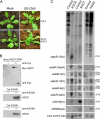


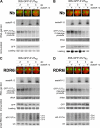

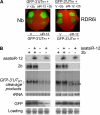
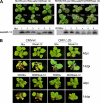
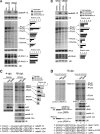
Similar articles
-
Satellite RNA reduces expression of the 2b suppressor protein resulting in the attenuation of symptoms caused by Cucumber mosaic virus infection.Mol Plant Pathol. 2011 Aug;12(6):595-605. doi: 10.1111/j.1364-3703.2010.00696.x. Epub 2011 Jan 17. Mol Plant Pathol. 2011. PMID: 21722297 Free PMC article.
-
Global analyses of small interfering RNAs derived from Bamboo mosaic virus and its associated satellite RNAs in different plants.PLoS One. 2010 Aug 2;5(8):e11928. doi: 10.1371/journal.pone.0011928. PLoS One. 2010. PMID: 20689857 Free PMC article.
-
Mapping helper virus functions for cucumber mosaic virus satellite RNA with pseudorecombinants derived from cucumber mosaic and tomato aspermy viruses.Virology. 1994 Dec;205(2):574-7. doi: 10.1006/viro.1994.1682. Virology. 1994. PMID: 7526544
-
Cucumber mosaic virus: viral genes as virulence determinants.Mol Plant Pathol. 2012 Apr;13(3):217-25. doi: 10.1111/j.1364-3703.2011.00749.x. Epub 2011 Oct 7. Mol Plant Pathol. 2012. PMID: 21980997 Free PMC article. Review.
-
Complex small RNA-mediated regulatory networks between viruses/viroids/satellites and host plants.Virus Res. 2022 Apr 2;311:198704. doi: 10.1016/j.virusres.2022.198704. Epub 2022 Feb 6. Virus Res. 2022. PMID: 35139407 Review.
Cited by
-
Endogenous activated small interfering RNAs in virus-infected Brassicaceae crops show a common host gene-silencing pattern affecting photosynthesis and stress response.New Phytol. 2021 Feb;229(3):1650-1664. doi: 10.1111/nph.16932. Epub 2020 Oct 14. New Phytol. 2021. PMID: 32945560 Free PMC article.
-
Long Noncoding RNAs in Plant Viroids and Viruses: A Review.Pathogens. 2020 Sep 18;9(9):765. doi: 10.3390/pathogens9090765. Pathogens. 2020. PMID: 32961969 Free PMC article. Review.
-
Small RNAs in plant defense responses during viral and bacterial interactions: similarities and differences.Front Plant Sci. 2013 Sep 5;4:343. doi: 10.3389/fpls.2013.00343. Front Plant Sci. 2013. PMID: 24046772 Free PMC article. Review.
-
VIGS as a strategy to reverse aphid wing induction by Y-satellite RNA of cucumber mosaic virus.FEBS Open Bio. 2023 Nov;13(11):2005-2019. doi: 10.1002/2211-5463.13697. Epub 2023 Aug 28. FEBS Open Bio. 2023. PMID: 37596957 Free PMC article.
-
Virus and Viroid-Derived Small RNAs as Modulators of Host Gene Expression: Molecular Insights Into Pathogenesis.Front Microbiol. 2021 Jan 14;11:614231. doi: 10.3389/fmicb.2020.614231. eCollection 2020. Front Microbiol. 2021. PMID: 33584579 Free PMC article. Review.
References
Publication types
MeSH terms
Substances
LinkOut - more resources
Full Text Sources

